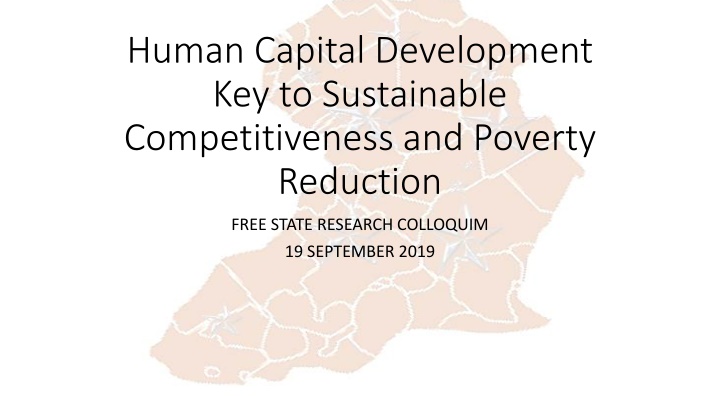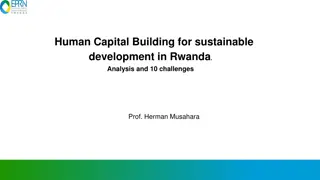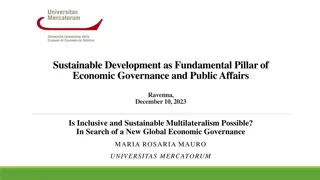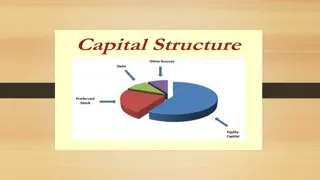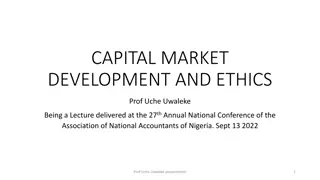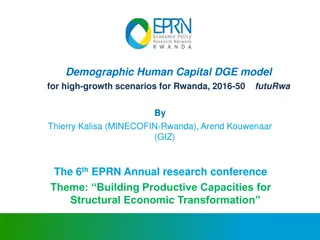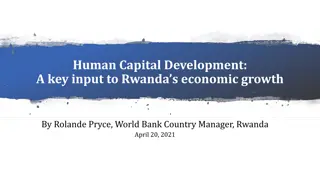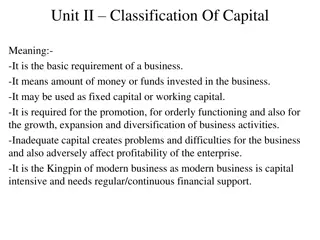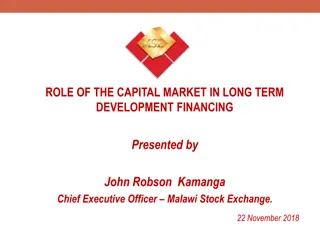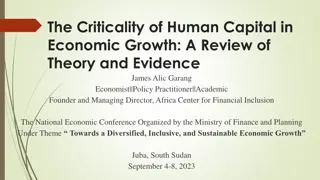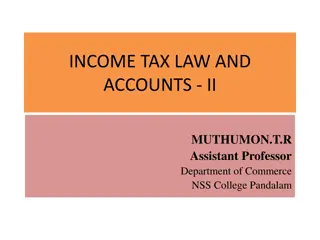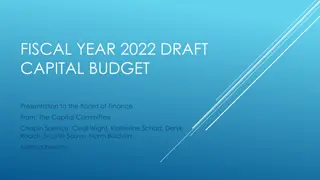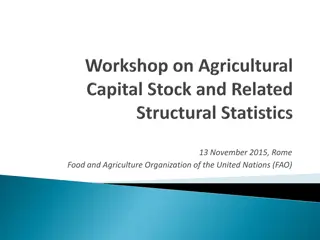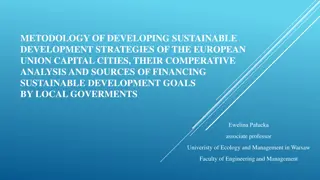Human Capital Development: Key to Sustainable Competitiveness
This research colloquium delves into the importance of human capital development for sustainable competitiveness and poverty reduction in South Africa. Topics covered include structural unemployment, education system challenges, and fiscal policies impacting poverty alleviation efforts.
Download Presentation

Please find below an Image/Link to download the presentation.
The content on the website is provided AS IS for your information and personal use only. It may not be sold, licensed, or shared on other websites without obtaining consent from the author.If you encounter any issues during the download, it is possible that the publisher has removed the file from their server.
You are allowed to download the files provided on this website for personal or commercial use, subject to the condition that they are used lawfully. All files are the property of their respective owners.
The content on the website is provided AS IS for your information and personal use only. It may not be sold, licensed, or shared on other websites without obtaining consent from the author.
E N D
Presentation Transcript
Human Capital Development Key to Sustainable Competitiveness and Poverty Reduction FREE STATE RESEARCH COLLOQUIM 19 SEPTEMBER 2019
INTRODUCTION Let me congratulate the Free State Government for the successful convening of this 4thAnnual Free State Provincial Research Colloquium; Let me express my gratitude for opportunity to be part of this empowering and foresighted initiative indeed this is a unique opportunity to present to yourselves some of my views with the hope of contributing to the dialogue on what I believe is one of the key challenges facing this country; In November of 2014 the World Bank published a document titled Fiscal Policy and Redistribution in an Unequal Society in which it was upbeat about the progress South Africa had made in reducing poverty through fiscal policy; When asked about the sustainability of the policy due to the fact that it created large social wage, the Bank replied in a conditional affirmative; On condition that the education system in South Africa yields successfully, the policy was sustainable.
STRUCTURAL UNEMPLOYMENT IN SOUTH AFRICA STRUCTURAL UNEMPLOYMENT IN SOUTH AFRICA There is strong consensus that unemployment in South Africa due to the mismatch between the demand and supply of labour Abhijit Banerjee, et al, conclude, inter alia, that unemployment in South Africa is structural There was increase in unemployment of the unskilled and those that have passed matric; There was an increase in the supply of unskilled labour aggravated by entry of women in the job market; There was increase in employment of those that have tertiary education training Skills constraint contributes to low demand for low skilled workers since skilled and low skilled jobs are complements (Ricardo Hausmann, 2008)
Struggling to Make the Grade: A Review of the Causes and Consequences of the Weak Struggling to Make the Grade: A Review of the Causes and Consequences of the Weak Outcomes of South Africa s Education System Prepared by Montfort Outcomes of South Africa s Education System Prepared by Montfort Mlachila Tlhalefang TlhalefangMoeletsi1 June 2019 Moeletsi1 June 2019 Mlachila and and While South Africa has made significant improvements in basic and tertiary education enrolment, there are significant challenges in the quality of educational achievement. The paper finds that money is clearly not the main issue since the South Africa s education budget is comparable to OECD countries as a percent of GDP and exceeds that of most peer sub-Saharan African countries in per capita terms. The main explanatory factors are complex and multifaceted: associated with insufficient subject knowledge of some teachers, history, race, language, geographic location, and socio-economic status. Low educational achievement contributes to low productivity growth, and high levels of poverty, unemployment, and inequality.
BASIC EDUCATION EXPENDITURE TRENDS R Million 1996 to 2017 ESTIMATED ATR 2 1 Trillion 2,500,000. 250,000.00 2,000,000. 200,000.00 Spending inEducation is totalling at least R2.1 trillion in eleven years 1,500,000. 150,000.00 1,000,000. 100,000.00 500,000. 50,000.00 - - 1996 1997 1998 1999 2000 2001 2002 2003 2004 2005 2006 2007 2008 2009 2010 2011 2012 2013 2014 2015 2016 2017 ACTUAL EXPENDITURE BUDGET
Skilled employment as a percentage of total employment within each population group, by age group. Adopted from Statistics South Africa 55-64 66 45-54 63 White 35-44 66 25-34 59 15-24 35 55-64 55 Indian 45-54 53 35-44 58 25-34 50 15-24 33 2017 1994 55-64 21 Coloured 45-54 22 35-44 24 25-34 19 15-24 11 Black African 55-64 19 45-54 20 35-44 18 25-34 14 15-24 10 0% 10% 20% 30% 40% 50% 60% 70%
China and India (Brics partners): Human Capital Development Both China and India have made significant advances in basic education in the last two decades. By 2005, India was producing 2.5 million new university-level graduates per year, 10 percent of whom were in engineering (Cooper 2006); China produced 3.4 million graduates, including 151,000 with postgraduate degrees (Chinese Statistical Abstract 2005, pp. 175 76). Currently, China is graduating 600,000 people in science and engineering mainly at the undergraduate level; By 2004, approximately one-fifth of the relevant age cohort in China was entering tertiary education (Cooper 2006). AT THIS STAGE I MUST CONGRADULATE THE FREE STATE GOVERNMENT ON THEIR SKILL DEVELOPMENT INITIATIVE
WHAT NEEDS TO BE DONE The demand for education outputs are clearly stated in the National Development Plan; Alfred Marshall who elaborated it in his book Principles of Economics (1920). Investors try to operate in a region where they can have sufficient access to a rich pool of labour and the skills become intergenerational. A cluster of companies in a particular location offers suppliers the chance to specialise and achieve economies of scale. New ideas or knowledge spread across firms that are located in the same region: Intergenerational skills. The Marshallian approach to economic development is widely accepted as a way to build competitive economies and industries having been advocated by Micha l Porter; Skills Development must, in the circumstances, be demand pulled and not production driven it must, therefore, be synchronised with the provincial development plan;
WHAT NEEDS TO BE DONE The Provincial Government may consider to engineer an Industrial Cluster Based Economic Development Plan in order to enhance demand pulled human capital development as well as sustainable competitiveness of the provincial economy; Plan must be led by government and should enable government in its totality (the three spheres including parastatals and other government agencies), the private sector and other key stakeholders, to concentrate effort targeting development at areas that are identified as having potential to yield optimum socio-economic benefits; Build social capital Five key groups of stakeholders in a production system (Government, Research Institutions, Financial Institutions, Investors/Entrepreneurs and Institutions for Collaboration) must agree on a development agenda within an identified geographical area and commit resources on a quid procure basis; The skills plan must address short term and long term employment and productivity levels: - Short term must address the current unemployed young people who in are unemployable through a refined Expanded Public Works Programme in PARTNERSHIP with the private sector; Government must insist, in the short to medium term, specific outputs from the schooling system with regard STEM; Linkages must be strengthened between the industrial clusters and the higher education institutions in order to enhance quality of training output that will lead to sustainable competitiveness of the local industries.
